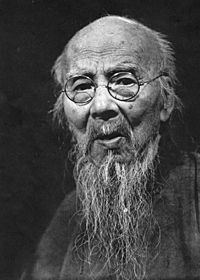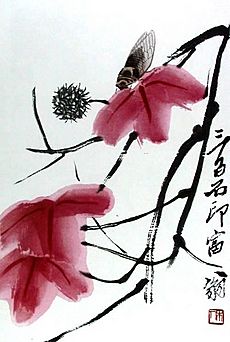Qi Baishi facts for kids
Quick facts for kids
Qi Baishi
|
|||||||||
|---|---|---|---|---|---|---|---|---|---|

Photo portrait of Qi Baishi in 1956
|
|||||||||
| Born | 1 January 1864 |
||||||||
| Died | 16 September 1957 (aged 93) Beijing, China
|
||||||||
| Known for | Painting | ||||||||
| Chinese name | |||||||||
| Traditional Chinese | 齊白石 | ||||||||
| Simplified Chinese | 齐白石 | ||||||||
|
|||||||||
Qi Baishi (born January 1, 1864 – died September 16, 1957) was a famous Chinese painter. He was known for his fun and imaginative style. Qi Baishi was born into a farming family in Xiangtan, Hunan, China.
He taught himself how to paint. A book called the Manual of the Mustard Seed Garden inspired him. After he turned 40, he traveled around China. He saw many beautiful places. In 1917, he made Beijing his home.
Qi Baishi's paintings often showed animals, plants, and everyday objects. He believed paintings should be a mix of real and imagined. Later in life, he often painted mice, shrimp, or birds. He was also skilled at carving seals. He even called himself "the rich man of three hundred stone seals." In 1953, he became the president of the China Artists Association. He passed away in Beijing in 1957.
Contents
Early Life and Art Beginnings
Qi Baishi was born in Xiangtan, Hunan. His family did not have much money. He lived with his parents, grandparents, and eight younger brothers and sisters. Qi went to school for less than a year because he was sick.
He was too weak for farm work. So, he became a carpenter. While working, he found a Chinese painting book. This book made him very interested in art. He started painting animals and insects. He learned from the Manual of the Mustard Seed Garden. He also used opera performers as models for his art. Later, he asked anyone he knew to pose for him.
Learning and Growing as an Artist
Qi Baishi learned art from a teacher named Hu Qinyuan. He learned the basics of gongbi painting. This style uses fine brushes and lots of detail. He was taught that every part of a painting was important. This included the subject and how the ink was put on the paper.
His next teacher, Tan Pu, helped him with landscape paintings. Because of this training, Qi realized he could be a full-time artist. Even though he learned gongbi, Qi became famous for his free xieyi style. This style means "sketching thoughts."
Qi was popular for his many different works. He painted plants and animals. His natural style attracted many art collectors. His art reflected his life and personality. After the Qing dynasty ended, Qi did not let politics change his art. He kept his own values and ideas. Starting from humble beginnings and becoming famous was very honorable.
Qi mastered many skills, including calligraphy and seal-carving. He became a known artist in Hunan. When he was in his forties, he started traveling. He looked for more ideas for his art. He met Wu Changshuo, a popular artist at the time. Wu became another mentor and inspired Qi's work. About fifteen years later, he met Chen Shizeng in Beijing. They became close friends.
Qi became more and more famous. During World War II, many traditional artworks were destroyed. But Qi was still respected. He was chosen for the National People's Congress. He also became the honorary Chairman of the National Artists Association. He showed that traditional art was still important in China. He died when he was 93 years old.
Building a Home and New Art Styles
After his travels, Qi built a house and settled down. He began to read and write poetry. He also painted the mountains he saw. These paintings became a series of fifty landscapes. They were called “Chieh-shan t’u-chuan.” Later, poems by artists Qi knew were added to these paintings.
One of Qi's early works, “The Carp,” was praised for its simple style. It had no extra decorations or writings. His skill with wood-carving was also highly praised. People admired how he put his own feelings into his art. Qi was considered a mature painter in his mid-fifties. By then, his lines were sharper. His paintings changed from wildlife to plants. He based his work on real life. He also tried new ways to express himself. He wanted to combine truth and beauty. He aimed to create something new and unique.
Qi Baishi's Artistic Vision
Once, Qi Baishi was talking to a student in Beijing. He saw the outline of a bird on a brick floor in muddy water. Not everyone would have noticed it. But Qi was always looking for new things to paint. He had a "special sensitivity." People said Qi was special because he always thought about painting. He had a strong desire to be a great artist.
Qi Baishi's own writings show his deep passion for his work. He wrote that he did not always follow old rules when carving seals. He felt that artists from the past were human, just like him. He believed artists today could also have their own unique styles. He admired artists who dared to make bold strokes in their paintings. He wished he had lived three hundred years earlier to learn from them. He hoped future generations would admire artists of his time.
What made Qi unique was that his art showed no Western influences. Most other artists at that time were influenced by Western styles. Other artists praised Qi for the "freshness" in his paintings. He painted familiar things like birds, flowers, insects, and landscapes. Qi was not the first to focus on small things in nature. But he was highly recognized for his thoughtful way of showing these subjects.
Many fake paintings are sold as Qi Baishi's work today. He is thought to have created between 8,000 and 15,000 paintings. About 3,000 of his works are in museums. But since 1993, over 18,000 paintings said to be by him have been sold at auctions. In 2011, a painting called Eagle Standing on Pine Tree was sold for a huge amount of money. It became one of the most expensive paintings ever sold. However, some people later doubted if it was a real Qi Baishi painting.
In 2017, his Twelve Landscape Screens painting sold for $140.8 million. This made him one of the few artists whose work has sold for over $100 million.
Qi Baishi's Family
Qi Baishi's first wife was Chen Chunjun. They married when Qi was twelve years old. They had five children together. They had three sons: Qi Liangyuan, Qi Liangfu, and Qi Liangkun. They also had two daughters whose names are not known.
In 1919, a woman named Hu Baozhu became Qi's second wife. Qi and Hu lived together in Beijing. They had seven children. They had four sons: Qi Liangchi, Qi Liangyi, Qi Liangnian, and Qi Liangmo. They also had three daughters: Qi Lianglian, Qi Lianghuan, and Qi Liangzhi.
Artistic Heritage
Many painters from the younger generation continued Qi Baishi's artistic style.
Children of Qi and Chen:
- Qi Liangkun (also known as Qi Ziru) and his son Qi Kelai.
Children of Qi and Hu:
- Qi Liangchi and his son Qi Zhanyi.
- Qi Liangyi and his son Qi Bingyi.
- Qi Liangmo and his son Qi Jianxiong and daughter Qi Huijuan.
- Qi Liangzhi and her son Xiong Zhichun and daughters Xiong Youyou and Qi Yuanyuan.
Qi Liangkun, Qi Liangyi, Qi Liangchi, Qi Liangmo, and Qi Liangzhi have kept the family art tradition alive. They actively paint in the style they learned from Qi Baishi. Xiong Zhichun was taught by Liangmo and Liangzhi. He later studied art abroad and developed his own unique style.
See also
 In Spanish: Qi Baishi para niños
In Spanish: Qi Baishi para niños
- Chinese painting
- Qi Baishi (crater)



